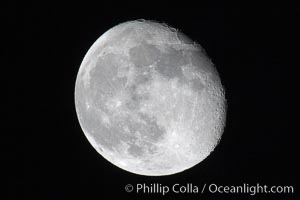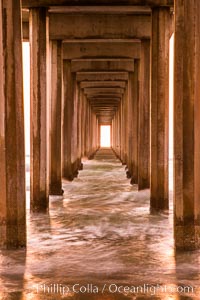
Scripps Pier solstice, sunset aligned perfectly with the pier.
Location: Scripps Institution of Oceanography, La Jolla, California
Image ID: 28477
Location: Scripps Institution of Oceanography, La Jolla, California
Image ID: 28477
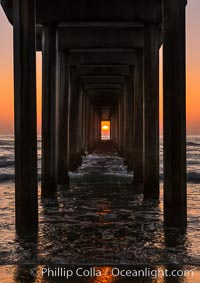
Scripps Pier solstice, sunset aligned perfectly with the pier.
Location: Scripps Institution of Oceanography, La Jolla, California
Image ID: 28478
Location: Scripps Institution of Oceanography, La Jolla, California
Image ID: 28478
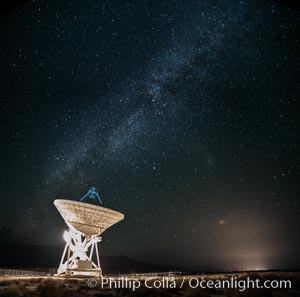
Radio telescope antenna, part of the Very Long Baseline Array (VLBA). The Very Long Baseline Array (VLBA) is a system of ten radio telescopes which are operated remotely from their Array Operations Center located in Socorro, New Mexico, as a part of the National Radio Astronomy Observatory (NRAO). These ten radio antennas work together as an array that forms the longest system in the world that uses very long baseline interferometry.
Location: Big Pine, California
Image ID: 28795
Location: Big Pine, California
Image ID: 28795
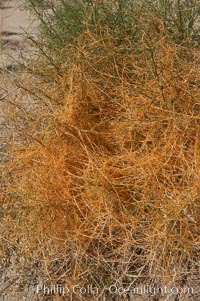
California dodder, a common stem parasite in California that typically parasitizes host shrubs. Dodders resemble tangled masses of orange spaghetti covering shrubs. Dodder is without chlorophyll and are nonphotosynthetic and is therefor an obligate parasite dependent on its host for water and nutrients through a root system that penetrates the stem tissue of the host.
Species: California dodder, Cuscuta californica
Image ID: 11333
Species: California dodder, Cuscuta californica
Image ID: 11333
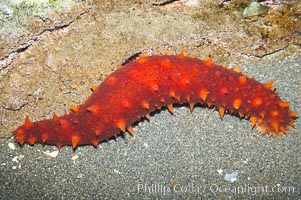
California sea cucumber. Sea cucumbers are related to sea stars and sea urchins. The sharp looking spines are soft to the touch and disappear into the skin when disturbed. If this visual defense doesnt work, the sea cucumber will expel its respiratory system. When this occurs in the wild it can regrow the lost organs.
Species: California sea cucumber, Parastichopus californicus
Image ID: 13732
Species: California sea cucumber, Parastichopus californicus
Image ID: 13732
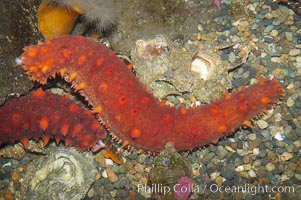
California sea cucumber. Sea cucumbers are related to sea stars and sea urchins. The sharp looking spines are soft to the touch and disappear into the skin when disturbed. If this visual defense doesnt work, the sea cucumber will expel its respiratory system. When this occurs in the wild it can regrow the lost organs.
Species: California sea cucumber, Parastichopus californicus
Image ID: 13733
Species: California sea cucumber, Parastichopus californicus
Image ID: 13733
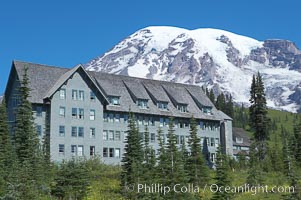
Paradise Inn. The Paradise Inn, one of the grand old lodges of the National Park system, was completed in 1906. Paradise Park, summer.
Location: Mount Rainier National Park, Washington
Image ID: 13908
Location: Mount Rainier National Park, Washington
Image ID: 13908
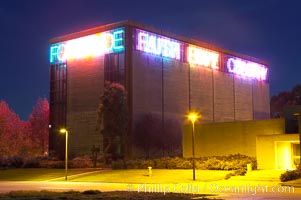
Vices and Virtues, part of the Stuart Collection and University of California, San Diego (UCSD). Artist Bruce Naumann created Vices and Virtues in 1988 along the top of the Charles Lee Powell Structural Systems Laboratory at UCSD. Vices and virtues named in alternating neon light blink bizarrely around the building, lighting the night sky at UCSD. Very odd.
Location: University of California, San Diego, La Jolla
Image ID: 14772
Location: University of California, San Diego, La Jolla
Image ID: 14772
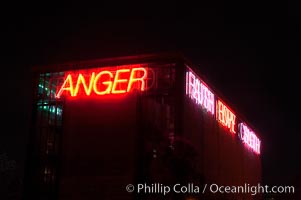
Vices and Virtues, part of the Stuart Collection and University of California, San Diego (UCSD). Artist Bruce Naumann created Vices and Virtues in 1988 along the top of the Charles Lee Powell Structural Systems Laboratory at UCSD. Vices and virtues named in alternating neon light blink bizarrely around the building, lighting the night sky at UCSD. Very odd.
Location: University of California, San Diego, La Jolla
Image ID: 14773
Location: University of California, San Diego, La Jolla
Image ID: 14773

Vices and Virtues, part of the Stuart Collection and University of California, San Diego (UCSD). Artist Bruce Naumann created Vices and Virtues in 1988 along the top of the Charles Lee Powell Structural Systems Laboratory at UCSD. Vices and virtues named in alternating neon light blink bizarrely around the building, lighting the night sky at UCSD. Very odd.
Location: University of California, San Diego, La Jolla
Image ID: 14774
Location: University of California, San Diego, La Jolla
Image ID: 14774
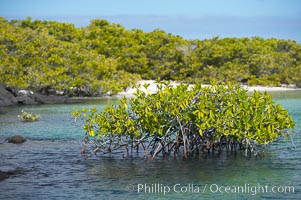
Mangrove shoreline. Mangroves have vertical branches, pheumatophores, that serve to filter out salt and provide fresh water to the leaves of the plant. Many juvenile fishes and young marine animals reside in the root systems of the mangroves. Punta Albemarle.
Location: Isabella Island, Galapagos Islands, Ecuador
Image ID: 16607
Location: Isabella Island, Galapagos Islands, Ecuador
Image ID: 16607
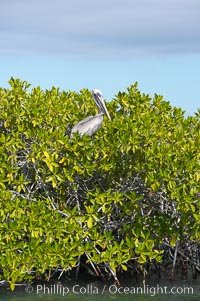
Mangrove shoreline. Mangroves have vertical branches, pheumatophores, that serve to filter out salt and provide fresh water to the leaves of the plant. Many juvenile fishes and young marine animals reside in the root systems of the mangroves. Punta Albemarle.
Location: Isabella Island, Galapagos Islands, Ecuador
Image ID: 16608
Location: Isabella Island, Galapagos Islands, Ecuador
Image ID: 16608
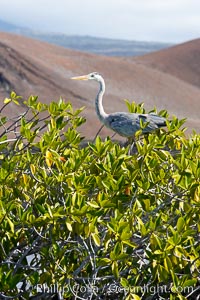
Mangrove shoreline. Mangroves have vertical branches, pheumatophores, that serve to filter out salt and provide fresh water to the leaves of the plant. Many juvenile fishes and young marine animals reside in the root systems of the mangroves. Punta Albemarle.
Location: Isabella Island, Galapagos Islands, Ecuador
Image ID: 16609
Location: Isabella Island, Galapagos Islands, Ecuador
Image ID: 16609
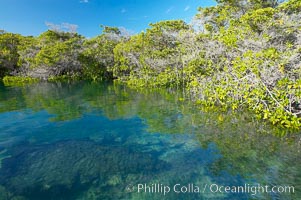
Mangrove shoreline. Mangroves have vertical branches, pheumatophores, that serve to filter out salt and provide fresh water to the leaves of the plant. Many juvenile fishes and young marine animals reside in the root systems of the mangroves. Punta Albemarle.
Location: Isabella Island, Galapagos Islands, Ecuador
Image ID: 16610
Location: Isabella Island, Galapagos Islands, Ecuador
Image ID: 16610
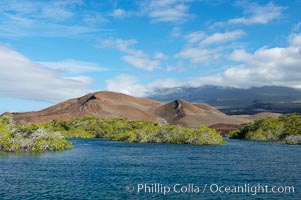
Mangrove shoreline. Mangroves have vertical branches, pheumatophores, that serve to filter out salt and provide fresh water to the leaves of the plant. Many juvenile fishes and young marine animals reside in the root systems of the mangroves. Punta Albemarle.
Location: Isabella Island, Galapagos Islands, Ecuador
Image ID: 16611
Location: Isabella Island, Galapagos Islands, Ecuador
Image ID: 16611
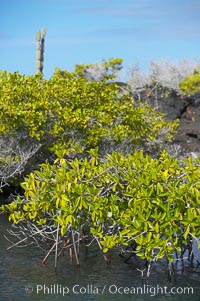
Mangrove shoreline. Mangroves have vertical branches, pheumatophores, that serve to filter out salt and provide fresh water to the leaves of the plant. Many juvenile fishes and young marine animals reside in the root systems of the mangroves. Punta Albemarle.
Location: Isabella Island, Galapagos Islands, Ecuador
Image ID: 16612
Location: Isabella Island, Galapagos Islands, Ecuador
Image ID: 16612
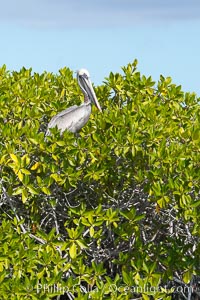
Mangrove shoreline. Mangroves have vertical branches, pheumatophores, that serve to filter out salt and provide fresh water to the leaves of the plant. Many juvenile fishes and young marine animals reside in the root systems of the mangroves. Punta Albemarle.
Location: Isabella Island, Galapagos Islands, Ecuador
Image ID: 16613
Location: Isabella Island, Galapagos Islands, Ecuador
Image ID: 16613
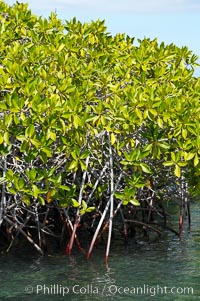
Mangrove shoreline. Mangroves have vertical branches, pheumatophores, that serve to filter out salt and provide fresh water to the leaves of the plant. Many juvenile fishes and young marine animals reside in the root systems of the mangroves. Punta Albemarle.
Location: Isabella Island, Galapagos Islands, Ecuador
Image ID: 16614
Location: Isabella Island, Galapagos Islands, Ecuador
Image ID: 16614
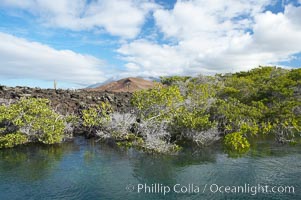
Mangrove shoreline. Mangroves have vertical branches, pheumatophores, that serve to filter out salt and provide fresh water to the leaves of the plant. Many juvenile fishes and young marine animals reside in the root systems of the mangroves. Punta Albemarle.
Location: Isabella Island, Galapagos Islands, Ecuador
Image ID: 16615
Location: Isabella Island, Galapagos Islands, Ecuador
Image ID: 16615
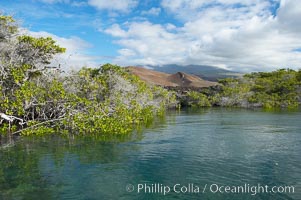
Mangrove shoreline. Mangroves have vertical branches, pheumatophores, that serve to filter out salt and provide fresh water to the leaves of the plant. Many juvenile fishes and young marine animals reside in the root systems of the mangroves. Punta Albemarle.
Location: Isabella Island, Galapagos Islands, Ecuador
Image ID: 16616
Location: Isabella Island, Galapagos Islands, Ecuador
Image ID: 16616
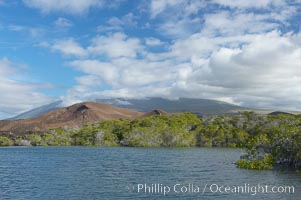
Mangrove shoreline. Mangroves have vertical branches, pheumatophores, that serve to filter out salt and provide fresh water to the leaves of the plant. Many juvenile fishes and young marine animals reside in the root systems of the mangroves. Punta Albemarle.
Location: Isabella Island, Galapagos Islands, Ecuador
Image ID: 16617
Location: Isabella Island, Galapagos Islands, Ecuador
Image ID: 16617

Lunar eclipse sequence, showing total eclipse (left) through full moon (right). While the moon lies in the full shadow of the earth (umbra) it receives only faint, red-tinged light refracted through the Earth's atmosphere. As the moon passes into the penumbra it receives increasing amounts of direct sunlight, eventually leaving the shadow of the Earth altogether. August 28, 2007.
Location: Earth Orbit, Solar System, Milky Way Galaxy, The Universe
Image ID: 19392
Panorama dimensions: 1835 x 6442
Location: Earth Orbit, Solar System, Milky Way Galaxy, The Universe
Image ID: 19392
Panorama dimensions: 1835 x 6442
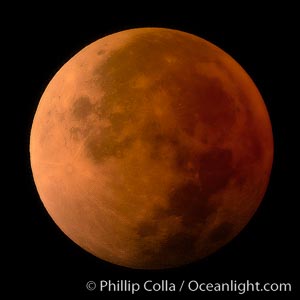
Blood red moon. During total eclipse the moon lies in the full shadow of the earth (umbra) and receives only faint, red-tinged light -- sunlight which is refracted through the thin layer of smoke- and haze-filled air that is Earth's atmosphere. August 28, 2007.
Location: Earth Orbit, Solar System, Milky Way Galaxy, The Universe
Image ID: 19450
Location: Earth Orbit, Solar System, Milky Way Galaxy, The Universe
Image ID: 19450
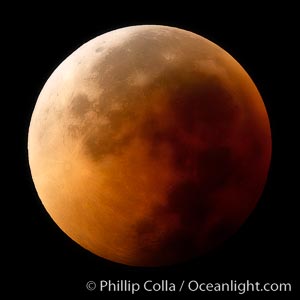
Blood red moon. During total eclipse the moon lies in the full shadow of the earth (umbra) and receives only faint, red-tinged light -- sunlight which is refracted through the thin layer of smoke- and haze-filled air that is Earth's atmosphere. August 28, 2007.
Location: Earth Orbit, Solar System, Milky Way Galaxy, The Universe
Image ID: 19451
Location: Earth Orbit, Solar System, Milky Way Galaxy, The Universe
Image ID: 19451
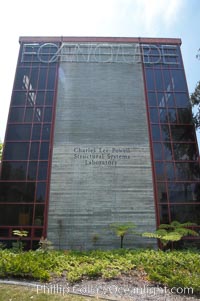
Charles Lee Powell Structural Systems Laboratory building, the earthquake testing lab, University of California, San Diego (UCSD).
Location: University of California, San Diego, La Jolla
Image ID: 20844
Location: University of California, San Diego, La Jolla
Image ID: 20844
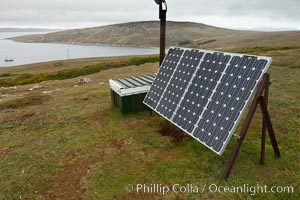
Solar electric panels, used to generate electricity on remote Westpoint Island in the Falklands.
Location: Westpoint Island, Falkland Islands, United Kingdom
Image ID: 23955
Location: Westpoint Island, Falkland Islands, United Kingdom
Image ID: 23955
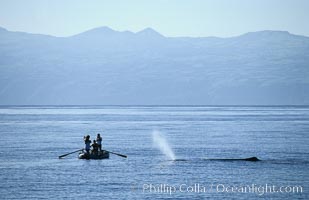
Sperm whale blows in front of Tokyo Broadcasting System film crew.
Species: Sperm whale, Physeter macrocephalus
Location: Sao Miguel Island, Azores, Portugal
Image ID: 02082
Species: Sperm whale, Physeter macrocephalus
Location: Sao Miguel Island, Azores, Portugal
Image ID: 02082

Route 66 (also known as U.S. Route 66, The Main Street of America, The Mother Road and the Will Rogers Highway) was a highway in the U.S. Highway system. One of the original federal routes, US 66 was established in 1926 and originally ran from Chicago through Missouri, Kansas, Oklahoma, Texas, New Mexico, Arizona, and California, before ending at Los Angeles for a total of 2,448 miles. US 66 was officially decommissioned (i.e., removed from the offical U.S. Highway system) in 1985 after it was decided the route was no longer relevant and had been replaced by the Interstate Highway System.
Location: California
Image ID: 20567
Location: California
Image ID: 20567

Route 66 (also known as U.S. Route 66, The Main Street of America, The Mother Road and the Will Rogers Highway) was a highway in the U.S. Highway system. One of the original federal routes, US 66 was established in 1926 and originally ran from Chicago through Missouri, Kansas, Oklahoma, Texas, New Mexico, Arizona, and California, before ending at Los Angeles for a total of 2,448 miles. US 66 was officially decommissioned (i.e., removed from the offical U.S. Highway system) in 1985 after it was decided the route was no longer relevant and had been replaced by the Interstate Highway System.
Location: California
Image ID: 20593
Location: California
Image ID: 20593
